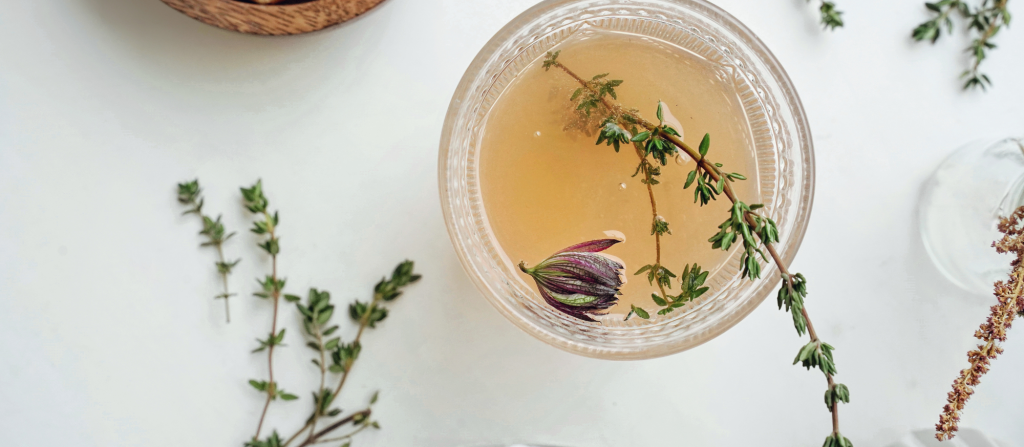
Understanding how herbs work and what actions they impart on the body is like stepping into a whole new world! There are many different ways an herb is categorized in order to understand how it may help you with a certain symptom or condition.
This blog post is going to go over herbal energetics, herbal actions, and give you a deeper understanding of herbalism. Learning this foundation of herbalism is powerful information for anyone who is interested in discovering more about what plants can do for the body.
Before we dive deep into herbal energetics and actions, I want to go over a few points that we need to consider when using herbs:
- Herbs are used to gently support the body and work in synergy with its systems.
Plants work to gently balance our body systems in order for the body to heal on its own. Don’t get me wrong, plants are powerful and we have to treat them with respect, but they aren’t going to generate a strong and fast action on the body in the same way a pharmaceutical would.
- Use herbs to support the person instead of addressing a symptom.
We want to look at the person as a whole to consider what they may need instead of isolating symptoms. There may be two people that have the same issue, but one person may need a different herb than the other person because of the many different root causes that come into play.
- Use herbs wisely and carefully.
Just because something is natural, it doesn’t mean it’s always safe for an individual. If you are interested in experimenting with herbs for yourself, take the time to do your own research from reputable herbal resources and start by using gentle, nutritive herbs. Referencing the Herbal Safely Continuum Scale is also helpful. Consulting with your practitioner about which herbs are safe for you is always advised.
Herbal Actions
The first thing you want observe when learning about an herb is it’s action. Herbal actions are going to give you a clue about which body system(s) an herb has an affinity for. This is one of the main ways to categorize an herb. It’s interesting to note that a single herb may have many different actions and rarely is only beneficial for one body system.
There are many different herbal actions, but I will highlight a few of them below:
Tonic
Tonic herbs are going to gently support a particular body system or the body as a whole. They are very gentle and work to improve the overall tone and function of an organ. For example, red raspberry is a reproductive system tonic that works to tone the uterus and the female reproductive system. Other examples of toning herbs include hawthorne which is a heart tonic, nettles as a general tonic for the body, and oats as a nervous system tonic.
Astringent
Astringent herbs cause tissues to tighten while having a pulling and drying effect. Herbs in this category can also help with inflammation in the body. Astringent herbs are great for healing scraps and cuts on the skin because of their pulling and tightening effect on the tissues. This category of herbs is also great to use when someone has leaky gut or gut permeability. The astringent action works to tighten up those loose junctures in the intestine. An astringent herb called horse chestnut is helpful for bulging veins such as hemorrhoids when we’re trying to tighten and tone a prolapsed vein. Other herbs in this category include white oak bark, witch hazel, comfrey, and shepherd’s purse.
Adaptogen
Adaptogenic herbs are going to help increase our body’s resistance to stress or help with the endurance in the midst of stress. Whenever you hear the word “adapt” in adaptogen, it gives us a clue that this plant is going to help us in adapting to a situation such as added stress, a new job, or any change in your life. This category of herbs is going to support adrenal health and improve issues with HPA (hypothalamus, pituitary, and adrenal) axis dysfunction. They also have a normalizing affect on the immune system by balancing our stress hormones. Adaptogenic herbs include ashwaghanda, Siberian ginseng, and eluthero root.
Bitter
Bitter herbs are going aid digestion by stimulating digestive enzymes that break down our food in order for it to be utilized by the body. They have an affinity for the liver and gallbladder by supporting detoxification and digestion of fats. Bitter herbs are wonderful when taken before meals to stimulate enzyme production as well as appetite. They are indicated for bloating, indigestion, and overall digestive support. Bitter herbs include gentian, dandelion, artichoke, and agrimony.
Demulcent
Demulcent herbs soothe and protect dry, inflamed, and irritated tissues in the body. A good example of using demulcents would be in the case of inflammatory gut issues like IBS or Crohn’s disease. Demulcents bring moisture back to tissues just like watering a garden’s dry, cracked soil. They also support the healing of dry inflamed tissues of your skin when applied topically in a poultice or salve. Dry scratchy throats can also become soothed with this category of herbs when drank as an infusion. Herbs in this category include marshmallow, slippery elm, aloe, and corn silk.
Vulnerary
Vulnerary herbs are typically used to help with the skin and healing bruises, cuts, and wounds. They help to protect against infection and stimulates cell renewal. Herbs included in this category are St. John’s wort, calendula, and comfrey.
Herbal Energetics
You will hear the word energetics a lot in herbalism which can describe an herb, a person (their constitution), or a condition or diagnosis.
Constitutions
Before we get into the energetics of an herb, I think it would be helpful to talk about constitutional types and energetics when it comes to individuals and symptoms. When we’re talking about the energetics of a person or health condition, we are describing it using different terms coined by Chinese and Indian medicine.
Traditional Chinese Medicine
In traditional Chinese medicine there are 5 different elements that comprise everything on the earth, including me and you. Individuals and things may be comprised of different amounts of these elements with some being more dominant than others.
Each of these elements have different characteristics and affect the body in different ways. TCM practitioners believe that there’s an imbalance in one of these elements when sickness shows up in the body.
The 5 elements include:
Wood:
- Body: Liver, gallbladder, tendons, eyes
- Color: Green
- Emotion: Anger
- Flavor: Sour
- Weather: Wind
Fire
- Body: Heat, tongue, pulse
- Color: Red
- Emotion: Joy
- Flavor: Bitter
- Weather: Heat
Water
- Body: Kidneys, ears, bones
- Color: Black
- Emotion: Fear
- Flavor: Salty
- Weather: Cold
Metal
- Body: Lung, nose, skin
- Color: White
- Emotion: Sadness
- Flavor: Pungent
- Weather: Dry
Earth
- Body: Spleen, stomach, mouth, muscles
- Color: Yellow
- Emotion: Pensive
- Flavor: Sweet
- Weather: Damp
Ayurveda
Ayurvedic medicine originates in India where practitioners believe that we are all born with a constitution that ultimately affects and influences our health. For the most part, our constitutions stay the same throughout life, but they can become balanced with food, herbs, and lifestyle choices.
Here are the 3 Ayurvedic constitutions:
Pitta
- Heat, fire, redness
- Great circulation, tends towards inflammation
Kapha
- Cool, damp, water
- Needs more stimulating, stagnant
Vata:
- Air, dry
- Needs moistening and nourishing herbs
Understanding a person’s constitution will help you to pick an herb according to what that constitution needs. For example, if someone had a Pitta constitution that deals with a lot of heat and inflammation (maybe they have rashes or heartburn), you would want to use a cooling and soothing herb such as slippery elm or marshmallow to balance out the heat.
Tastes and Flavors
When we are describing the energetics of an herb, we are going by its tastes and flavors. Years ago before we had textbooks about herbs, herbalist who were discovering new plants would classify an herb by how it tasted when they put it in their mouth. If the plant made their mouth pucker and tighten they knew that that plant has astringent properties. If it was sweet or mild they knew it would be more of a building and nutritive herb. This is how we first discovered actions of herbs before we even formally knew about them. The taste and flavor of a plant gives us great clues as to what it will do for the body.
There are about 6 different tastes and flavors that originate from traditional Chinese medicine and Ayurvedic medicine. When you learn these tastes and flavors, it will help you to have a deeper understanding of an herb and how it can help you.
Sour
Affect on the body: Hot, wet, and light
Organs Associated: Liver and gallbladder
TCM Element: Wood
- Sour herbs are moistening to our tissues because they increase saliva
- They are astringent, anti-inflammatory, and antioxidant
- Too much sour can also be drying (such as lemon water) so we need a balance
- Helps with lack of motivation and focus
- Digestive aid
Sour Herbs: Lemon
Astringent (similar to sour)
Affect on the body: Tightening
- Puckering feeling in mouth
- Helps to tighten loose tissues
- Healing for external wounds
Astringent Herbs: Black tea, witch hazel, white oak bark
Bitter
Affect on the body: Cooling, dry, and light
TCM Element: Fire
Organs Associated: Heart, liver and small intestines
- Anti-inflammatory
- Helps with excess heat and infections
- Stimulates digestion
- They have a downward energy to keep food moving from the stomach and into the intestines
Bitter Herbs: Artichoke, gentian, dandelion
Sweet
Affect on the body: Wet, cold, and heavy
Organs Associated: Spleen, stomach
TCM Element: Earth
- Building and nutritive
- Lubricates and moistens
- Calming and centering for the nerves
- Nutritive, bland, and can be more earthy
Sweet Herbs: Astragalus root and licorice root
Salty
Affect on the body: Heavy, hot, and wet
TCM Element: Water
Organs Associated: Kidneys and adrenals
- Grounding, warming, soothing
- Supports adrenals
- Restorative
- Nutritive
- Strengthening for bones and teeth
- Mineral-rich, great for hair, skin, and nails
Herbs: Nettle, chickweed, oatstraw
Pungent
Affect on the body: Hot, dry, light, spicy, very sharp to the taste
TCM Element: Metal
Organs Associated: Lungs, large intestine
- Promotes circulation to help with bringing blood flow to extremities
- Great for stagnation
Herbs: Cayenne, oregano, rosemary
Working with Herbs
Now that you have a good understanding of herbal actions, energetics, and constitutional types, I hope this gives you a head start in understanding the effects of an herb and what it will do for the body. It will also empower you to start experimenting with herbs when you experience symptoms. Stepping into the world of herbalism is like going to a new place that you’ve never been before! I hope you come to love and enjoy these amazing plants just as much as I do!
Happy medicine making,
-Hannah
Disclaimer:
All information contained within this article is meant for educational use only and is not meant to treat or diagnose any disease.
